Whole Tone Scale: How To Use In Piano Music
 Would you like to learn how to use the whole tone scale?
Would you like to learn how to use the whole tone scale?
You’re in the right place.
In this tutorial, you’ll learn what is a whole tone scale and how to apply it in music.
Let’s get started.
How To Differentiate Between Semitones and Whole Tones On The Keyboard
Before we know what this scale really is, we have to know what a whole tone is on the keyboard.
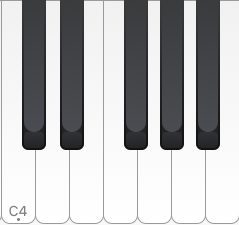
Above is an image of all the 12 notes of the keyboard within the span of close to an octave. They simply repeat themselves over and over.
The distance from one key fo the next is a semitone or half step apart. It’s easier to see if we ignore the lower half of the keyboard like this:
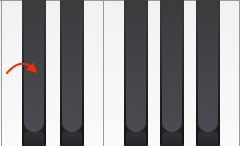
The whole tone, on the other hand, is a distance that spans 3 keys on the keyboard:
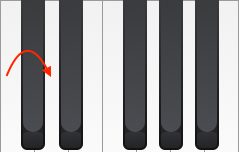
As we go further along the lesson, I’ll show some illustrations in standard written notation.
Learn how to read piano sheet music.
Now let’s learn how to construct a whole tone scale.
How To Play A Whole Tone Scale On The Piano
 Discovering this scale on the piano is super easy.
Discovering this scale on the piano is super easy.
A whole tone scale is what it says it is: a scale made up entirely of whole tones.
The best part about it is that to learn the scale in all 12 keys, you only need to learn 2 shapes.
Here are the 2 whole tone shapes on the piano:
Shape 1:
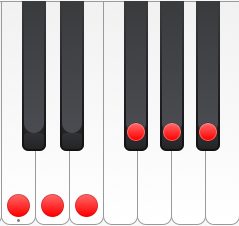
By learning Shape 1, you can now effectively play whole tone scales in C, D, E, F#/Gb, Ab, and Bb.
Shape 2:
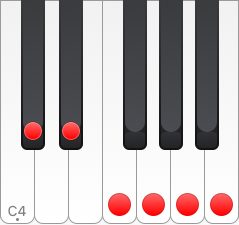
Once you have Shape 2 mastered, whole tone scales in Db, Eb, F, G, A, and B are now under your fingertips.
Why Learning 2 Shapes Allows You To Master 12 Whole Tone Scales
The reason why 2 shapes lead to 12 in an instant is that it is a symmetrical scale.
Being a symmetrical scale, each note works as a root note for one scale shape.
This is why learning just one shape gets you access to 6.
Now let’s look at some musical examples where the whole tone scale is used.
3 Whole Tone Scale Application Examples
Without a doubt, one composer that has mastered the use of the whole tone scale is Claude Debussy.
Here’s Debussy’s “Reflets Dans L’Eau”, a solo piano piece that makes use of Shapes 1 and 2 to a great extent:
The next example is in the Stevie Wonder classic “You Are The Sunshine Of My Life”:
Towards the heavier side of things, we can hear the scale at work in Dream Theater’s “The Dance of Eternity”, especially in the opening runs of the tune:
Now let’s take a look at how to learn some whole tone scale moves.
How To Play The Whole Tone Scale On The Piano
Playing It Melodically
The finger pattern you need to take note of is the 12-1234 pattern.
For Shape 1, simply use the fingering pattern starting on C like this:

For Shape 2, start on F and play the scale with the same fingering:

Now that we have each note of the scale out of the way, let’s learn some chords derived from it.
Performing Harmonies A La Debussy
There are 2 really cool and mysterious sounding chords you can start learning.
To start off, we have a dominant 7(#5) chord. This one is a C7(#5):
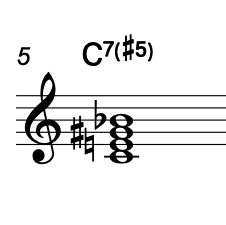
Secondly, we have a dominant 7(b5) chord. This is a C7(b5) chord:
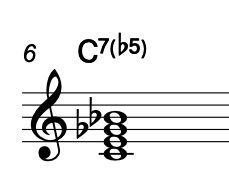
Start by learning these first 2 chords. After that, transpose these chord shapes in other keys.
Remember, the chords you just learned come from the scale itself. As long as you follow the intervals of each note in the chord, you can easily learn each chord voicing in all 12 keys.
How To Practice And Apply In Music
 Any melody or harmony from this scale always functions as a V chord (dominant).
Any melody or harmony from this scale always functions as a V chord (dominant).
Therefore hearing it always creates some tension and an expectation of resolution to a key.
For example, in a ii-V-I chord progression in C, you apply the scale or chord over G7.
It can also work in a sequence of secondary dominants. For instance, you may have something like D7 – G7 – Cmaj7 as a chord progression.
In this case, you can use Shape 1 on D7 and Shape 2 on G7 then resolve to a major or a lydian scale on Cmaj7.
You need to be aware, however, that using this scale creates a dream-like, hazy quality to the music.
Depending on the chord progression and delivery, it can also sound tense, even disturbing.
Therefore, it’s important to resolve the scale to something more consonant so the music sounds settled and satisfying.
In conclusion, using this scale to great effect and intent is the end goal to create great music with it.
Final Words
I hope you enjoyed this lesson.
If you have questions, comments, or suggestions, leave a note in the comments below.
Have fun practicing and thanks for stopping by PianoLessonsOnline.com!
